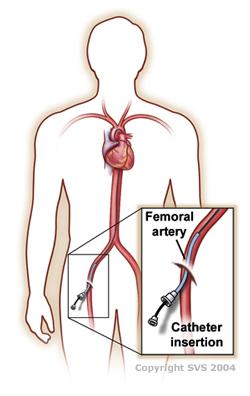An angiogram is an X-ray procedure that can be both diagnostic and therapeutic. It is considered the gold standard for evaluating blockages in the arterial system. An angiogram detects blockages using X-rays taken during the injection of a contrast agent (Iodine dye). The procedure provides information that helps your vascular surgeon determine your best treatment options.
Angiograms are typically performed while you are sedated. The procedure may last 15-20 minutes or up to several hours, depending on how difficult the test is and how much treatment is needed.
An angiogram is commonly performed under sedation with the use of local anesthesia.
- The procedure starts by injecting local anesthesia into the area where artery will be accessed by a needle.
- Once the area is numbed a needle is put into the artery either in the groin or the arm. From one access site, most blood vessels in the body can be reached and treated.
- Most often, an ultrasound is used to identify the target blood vessel for puncture.
- After access is established, catheters (thin tubes) and wires are threaded through the arterial system to a specific area of interest or throughout the entire body.
- As a contrast agent (iodine dye) is injected, X-ray images are taken to let your vascular surgeon view the flow of the dye and identify blockages. The surgeon can then choose the best mode of therapy for you – either at the same time or plan for a future treatment procedure. This decision depends on your symptoms and the severity and characteristics of the blockages.
- At the conclusion of the procedure, your surgeon may place plugs at the access site in the artery to close the hole and reduce the chance of bleeding. Pressure may also be held at the puncture site with or without the plug and you must lay flat for some time to prevent bleeding.
- Two common therapies that can be provided during the angiogram are balloon angioplasty and stent placement.
Angioplasty can be used to open arterial blockages. Guided by X-ray, your vascular surgeon navigates through the blockage with a wire and introduces a special device equipped with an inflatable balloon. After positioning the balloon across the blocked portion of the artery, the vascular surgeon inflates the balloon to expand the artery and compress the blockage. The balloon is then deflated and removed while keeping the wire in place across the area that has been treated. Next, a contrast dye is injected to assess the result. Treatment is considered a success if blood flow is improved and less than 30% of the blockage remains. If the vessel is still considerably narrowed or the blockage is considerable risk for recurring, placing a stent may be the next step.
Stents are used to prop open an artery at the site of a narrowing. Stents are placed after balloon angioplasty when there is residual narrowing or insufficient blood flow in a treated vessel. Stents are considered a permanent implant and cannot be used if you have a metal allergy. Stents that are used in the leg are constructed of a nickel-titanium alloy (Nitinol), a memory-shaped metal. This alloy has a predetermined size and shape at body temperature and expands to this size and shape after being introduced through a catheter. These stents resist kinking and are flexible so that damage from activities that involve your legs is minimized.
If surgery is felt to be a better option, your vascular surgeon will obtain any additional X-ray images needed to plan a surgical bypass of the blocked vessel/s and will then conclude the angiogram.

All invasive procedures can have complications. While the risk of an angiogram is low, it is not zero. The most common complications are related to the arterial access site including:
- Bruising is common: You will have bruising (ecchymosis) where the artery was entered.
- Pain and bleeding: Less commonly, patients experience pain and bleeding that may include blood collecting under the skin (hematoma).
- Blockage or leakage: In rare cases, the access artery can become blocked. Infrequently, patients experience persistent leakage of blood where the artery was entered, which can result in the formation of a pseudoaneurysm—a blood-filled sac—that may require further treatment.
Other complications related to an angiogram include:
- Allergic reaction to the iodine contrast dye, which can lead to the development of kidney failure.
- Very rarely during balloon angioplasty and/or stent placement, part of the arterial blockage can break off (embolism) and travel to more distant arteries. This can worsen blood flow and may require further interventions. In severe but rare cases, this may lead to amputation and/or limb loss.
- Angiograms (with or without balloon angioplasty/stenting) are considered outpatient procedures and patients usually go home the same day.
- After the procedure, expect 4-6 hours of bed rest to avoid bleeding at the artery access site.
- Because sedation is often utilized, you will not be able to drive yourself home. Be sure to arrange for transportation after the procedure.
- Once home, you should avoid heavy lifting, stooping or bending for 2 days to reduce the risk of bleeding at the arterial puncture site. Most other activities can be resumed.
